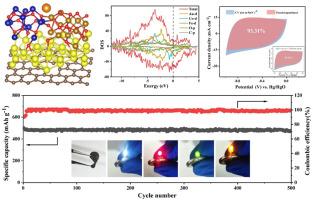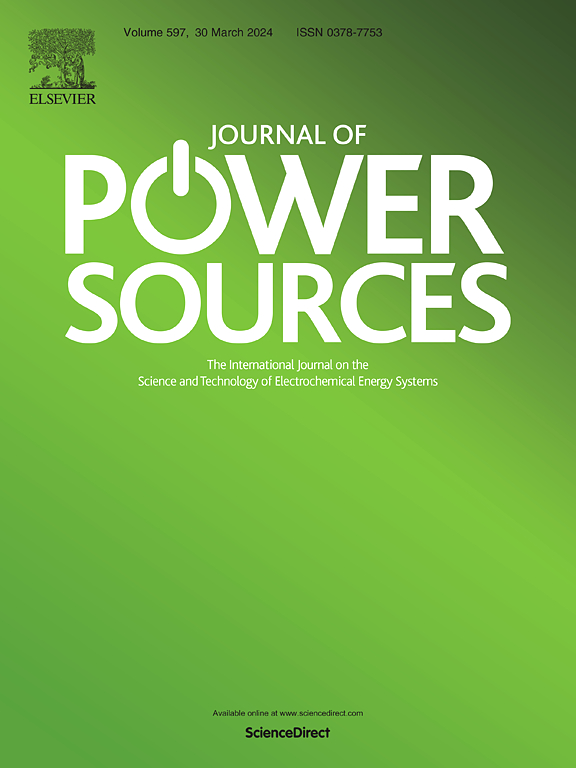(Fe, Co) oxide nanowires on gold nanoparticles modified MOF-derived carbon nanoflakes for high-efficiency sodium-ion batteries and supercapacitors across electrolytes
IF 8.1
2区 工程技术
Q1 CHEMISTRY, PHYSICAL
引用次数: 0
Abstract
The three-dimensional conductive porous carbon nanosheets (CPCN) are from the bimetallic metal-organic framework (MOFs) consisting of organic ligating groups that incorporate zinc and cobalt ions deposited onto a flexible carbon cloth (CC). Utilizing a hydrothermal approach, iron-cobalt oxide (FCO) nanowires are intricately embedded onto CPCN modified with gold (Au), forming a flexible FCO/Au/CPCN@CC electrode. The electrochemical characteristics of electrodes are evaluated in 1 M Na2SO4, supercapacitor's storage capacity is tested at 4 V using 1 M NaPF6 electrolyte. Among its remarkable attributes are a peak energy density of 291.5 W h kg−1 achieved at a power density of 153.85 W kg−1, and even at the maximum power density of 1749.9 W kg−1, it maintains 144.78 W h kg−1. Undergoing 10,000 rounds of GCD, the equipment sustains a capacitance retention of 84.27 %. Moreover, the performance of the FCO/Au/CPCN@CC anode in sodium-ion batteries (SIBs) is assessed. At 0.1C, the discharge capacity reaches 958 mAh g−1, and there is almost no loss after the rate cycle. The Coulomb efficiency surpasses 98 % during 500 cycles at a large C-rate. The integration of Au nanoparticles onto the CPNC surface enhances the energy storage characteristic of the FCO/Au/CPCN@CC composite material in both battery and supercapacitor applications.

(金纳米粒子上的(铁、钴)氧化物纳米线修饰 MOF 衍生的碳纳米片,用于跨电解质的高效钠离子电池和超级电容器
三维导电多孔碳纳米片(CPCN)来自双金属金属有机框架(MOF),该框架由有机配位基团组成,将锌和钴离子沉积在柔性碳布(CC)上。利用水热法将铁钴氧化物(FCO)纳米线错综复杂地嵌入到用金(Au)修饰的 CPCN 上,形成了柔性 FCO/Au/CPCN@CC 电极。在 1 M Na2SO4 中对电极的电化学特性进行了评估,并使用 1 M NaPF6 电解质在 4 V 电压下测试了超级电容器的存储容量。其显著特点包括:在功率密度为 153.85 W kg-1 时,峰值能量密度达到 291.5 W h kg-1;即使在最大功率密度为 1749.9 W kg-1 时,也能保持 144.78 W h kg-1。在进行 10,000 次 GCD 时,设备的电容保持率为 84.27%。此外,还评估了 FCO/Au/CPCN@CC 阳极在钠离子电池 (SIB) 中的性能。在 0.1C 下,放电容量达到 958 mAh g-1,并且在速率循环后几乎没有损失。在大 C 速率下循环 500 次,库仑效率超过 98%。金纳米颗粒与 CPNC 表面的结合增强了 FCO/Au/CPCN@CC 复合材料在电池和超级电容器应用中的储能特性。
本文章由计算机程序翻译,如有差异,请以英文原文为准。
求助全文
约1分钟内获得全文
求助全文
来源期刊

Journal of Power Sources
工程技术-电化学
CiteScore
16.40
自引率
6.50%
发文量
1249
审稿时长
36 days
期刊介绍:
The Journal of Power Sources is a publication catering to researchers and technologists interested in various aspects of the science, technology, and applications of electrochemical power sources. It covers original research and reviews on primary and secondary batteries, fuel cells, supercapacitors, and photo-electrochemical cells.
Topics considered include the research, development and applications of nanomaterials and novel componentry for these devices. Examples of applications of these electrochemical power sources include:
• Portable electronics
• Electric and Hybrid Electric Vehicles
• Uninterruptible Power Supply (UPS) systems
• Storage of renewable energy
• Satellites and deep space probes
• Boats and ships, drones and aircrafts
• Wearable energy storage systems
 求助内容:
求助内容: 应助结果提醒方式:
应助结果提醒方式:


